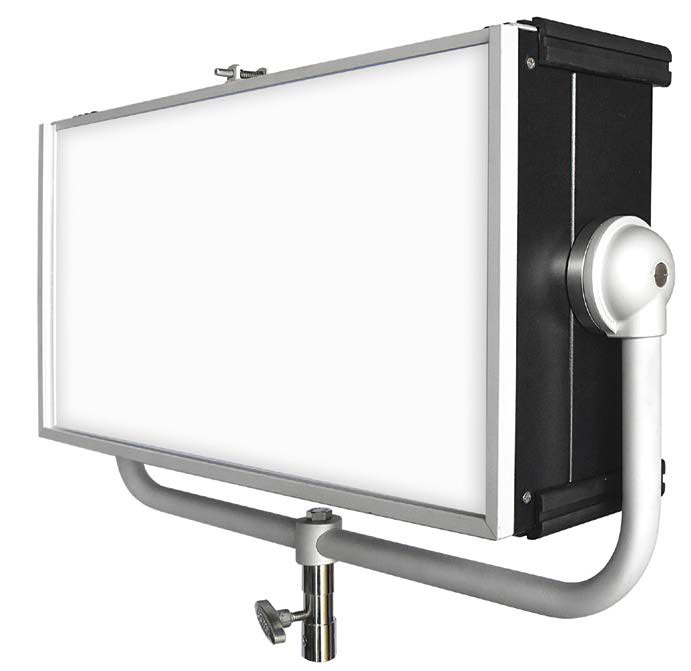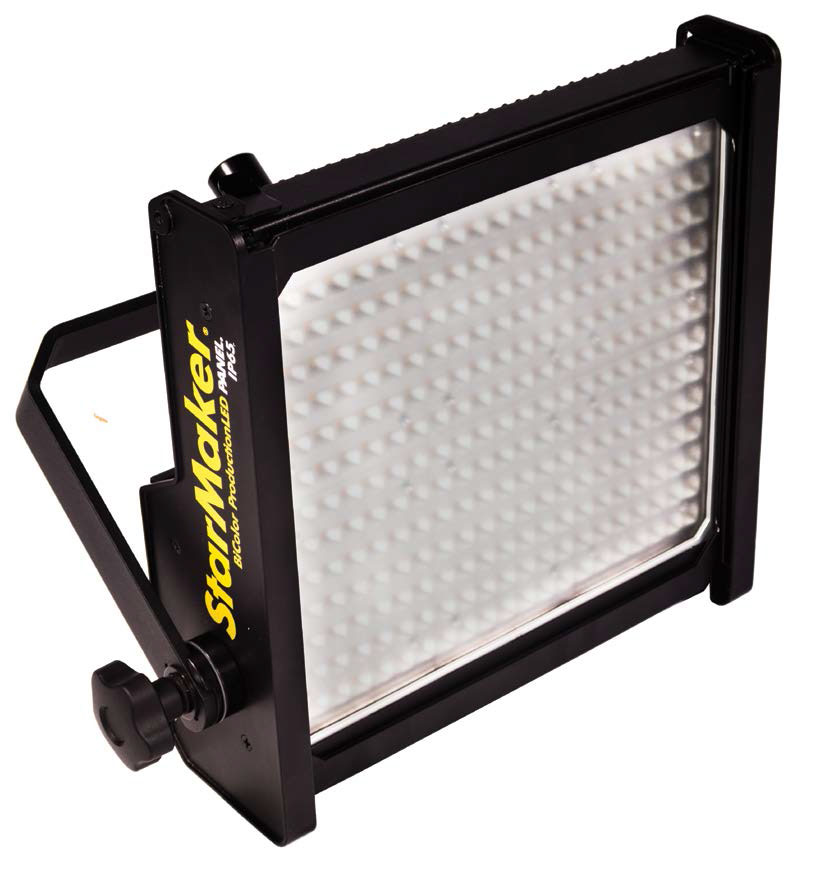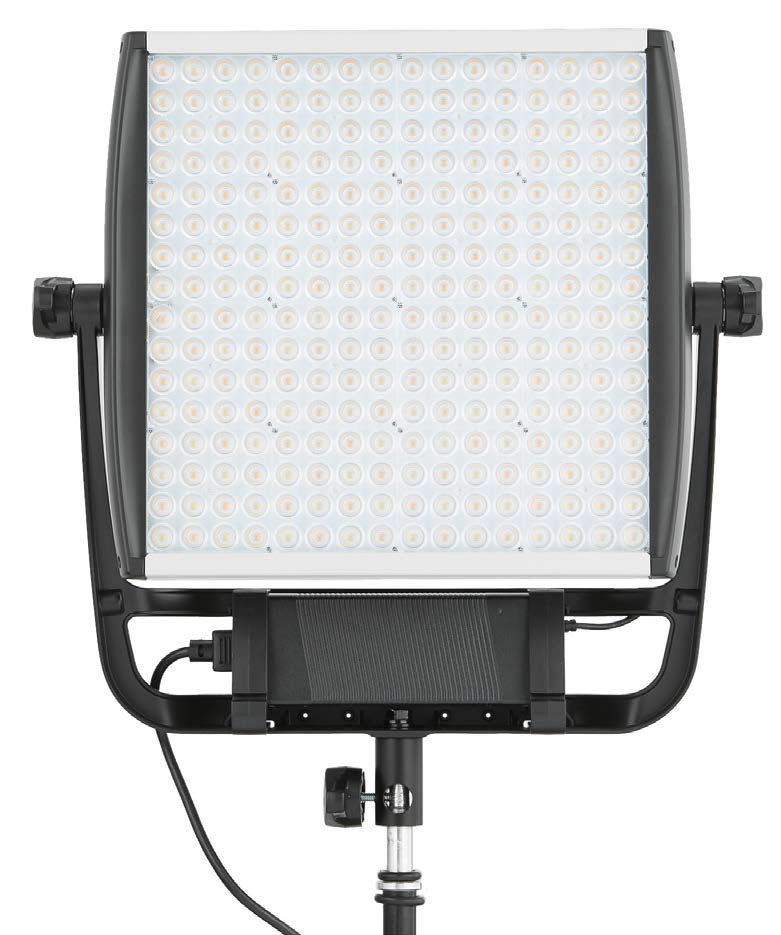Lighting for Broadcast: LEDs Come of Age
SEATTLE—Light emitting diodes (LEDs) were invented in the early 1960s, and have been used in television and video lighting for about the past dozen years. Advances in LEDs have prompted the technology to go in a variety of new and interesting directions.

“What we’re seeing is definitely a move to RGBW [red, green, blue and white] LED lighting that allows for a fully tuneable fixture,” said Mike Wagner, senior product manager with the lighting division of ARRI.
ARRI has been making nothing but RGBW LED fixtures since they introduced their first LED light, the L7 in 2011. That and subsequent ARRI lights like the Skypanel not only are able to match ambient light temperature, “but also are able to set the magenta point or select vivid colors that will allow more versatility in the studio, whether that be different types of setups during their day, or one-time-only special events,” Wagner said.
Another trend Wagner sees is firmware updates for light fixtures. “These aren’t just updates that fix bugs or something like that,” he said. “We are adding new functionality to our lights. That has been our commitment to our customers.”
ARRI’s latest firmware provides the ability to create professional level lighting effects without the need of a lighting console, and adds different kinds of communications control as well.

DYNAMIC LIGHTING EFFECTS
Rich Pierceall, CEO of Cineo thinks the trend building color into LED fixtures is not going to go away. His company has built a number of fixtures that include both tuneable white light and saturated colors, including the Standard 410, just released at the recent Cine Gear Expo.
The professional video industry's #1 source for news, trends and product and tech information. Sign up below.
Pierceall thinks the next wave is dynamic lighting effects. “What’s now happening is that a lot of larger fixtures are made capable of being carved up into small fixtures,” he said. “In other words, I can actually get light movement across the face of the lighting fixture.”
Cineo has developed the LightBlade fixtures in partnership with NBCUniversal. The larger LightBlade fixtures utilize Cineo Zone Control technology, which provide for 10 zones within the fixture being independently controlled. This gives users the ability to change color and intensity between LightBlades simultaneously.
Another area to watch is lighting control. “People are going to be branching away from traditional DMX universes and getting into far more elegant, far more advanced control systems,” Pierceall said.

LIGHTING DESIGN
Not everybody is climbing aboard with RGBW light fixtures yet.
“I’m not too sure that trend is right,” said Ing. Jose Maria Noriega, chief marketing officer for Fluotec. “And as with every trend, sometimes it stays and sometimes it goes away.”
Noriega doesn’t think talent should be colorized. “You colorize the set, or you colorize the background, the stage,” he said.
And while he says it might be convenient having saturated color capability in every fixture, “I don’t know if all TV stations would be willing to just follow that trend, especially the cost, if they are going to use this feature 2 percent of the time they’re going to use it for pure white light. Can you imagine 30 years ago that you would look back on the television industry and say ‘Hey, let’s have some lights that cost $17,000?’”
There is one trend in professional lighting for broadcast that Noriega is noticing.
“Lighting designers for cinema are now getting into lighting design for television,” he said. “These people are asking for pure white light, they are asking for reliability, they are asking for power, and they are also asking for a good price.”

LESS POWER
Litepanels’ Gemini 2x1 soft panel fixtures provide RGBW capability in the fixture, and the company sees more of that in the future. In addition, LEDs are getting more power-efficient, according to Byron Brown, product manager for Litepanels.
“Our LED technology today is roughly 30 to 50 percent more efficient than it was even three or four years ago,” he said. “The technology advancement of LEDs gets us even more efficiencies and better brightness per Watt in the LED world, let alone compared to tungsten and other sources.”
Because the company’s first 1x1 LED panel lights were introduced 10 years ago, a direct efficiency comparison can be made to its current Astra 6X, which is 6x brighter than the original 1x1. Complicating the math in this comparison is the fact that the Astra 6X uses 50 percent more, so the efficiency itself is about double.
Brown also notes that although the Astra 6X fixture is 6x times brighter than the original 1x1, it sells for about half what original 1x1 did.
[Read: Despite The Hype, LEDs Haven’t Revolutionized Broadcasting]
“So it’s 6x brighter for even less money than we were selling the 1x version 10 years ago,” he said.
Brown credits a number of factors for the lower cost: “All manufacturers have needed to find better ways to manufacture the product more efficiently. I think the volumes have also gone up, not just in terms of components, but also manufacturing processes. The number of units we sell today is substantially higher than the original 1x1 panels as well, so I think volume, efficiencies, component costs, all of those have contributed to the lower prices. And obviously competition has played a part.”
MORE FEATURES
Similarly, Scott Stueckle, sales manager at Kino Flo Lighting Systems sees the industry pressing to offer more features in their lighting fixtures for less money.
Kino Flo is a pioneer in fluorescent television and motion picture lighting equipment. They’ve transitioned their fluorescent fixtures such as the Diva and Celeb into LED lights, retaining the features that made them popular.
“Kino Flo is still focused on the white space, shooting in the color space that cameras can see, the full color spectrum, trying to keep our color on the black body curve,” Stueckle said.
And just as the company worked with fluorescent tube makers to optimize color rendering for their original light products, they’ve done the same thing with its LEDs, working with LED suppliers on both the design and manufacturing process, so that the LEDs perform exactly as the company specifies. “And we have proprietary technology to actually apply a spectrometer that reads a camera’s color sensitivity,” Stueckle added.
Stueckle says the combination of software and hardware has changed the development of professional lighting technology.
“In the old days we just used to make lights,” he said. “We’re now basically designing and programming computers that have lights on them. And I think you’re seeing more of that, and more people are getting involved with that, and things are getting better and better and prices are dropping more over the next few years.”
Professional lighting manufacturers are betting their companies on their ability to chase the right trend.
